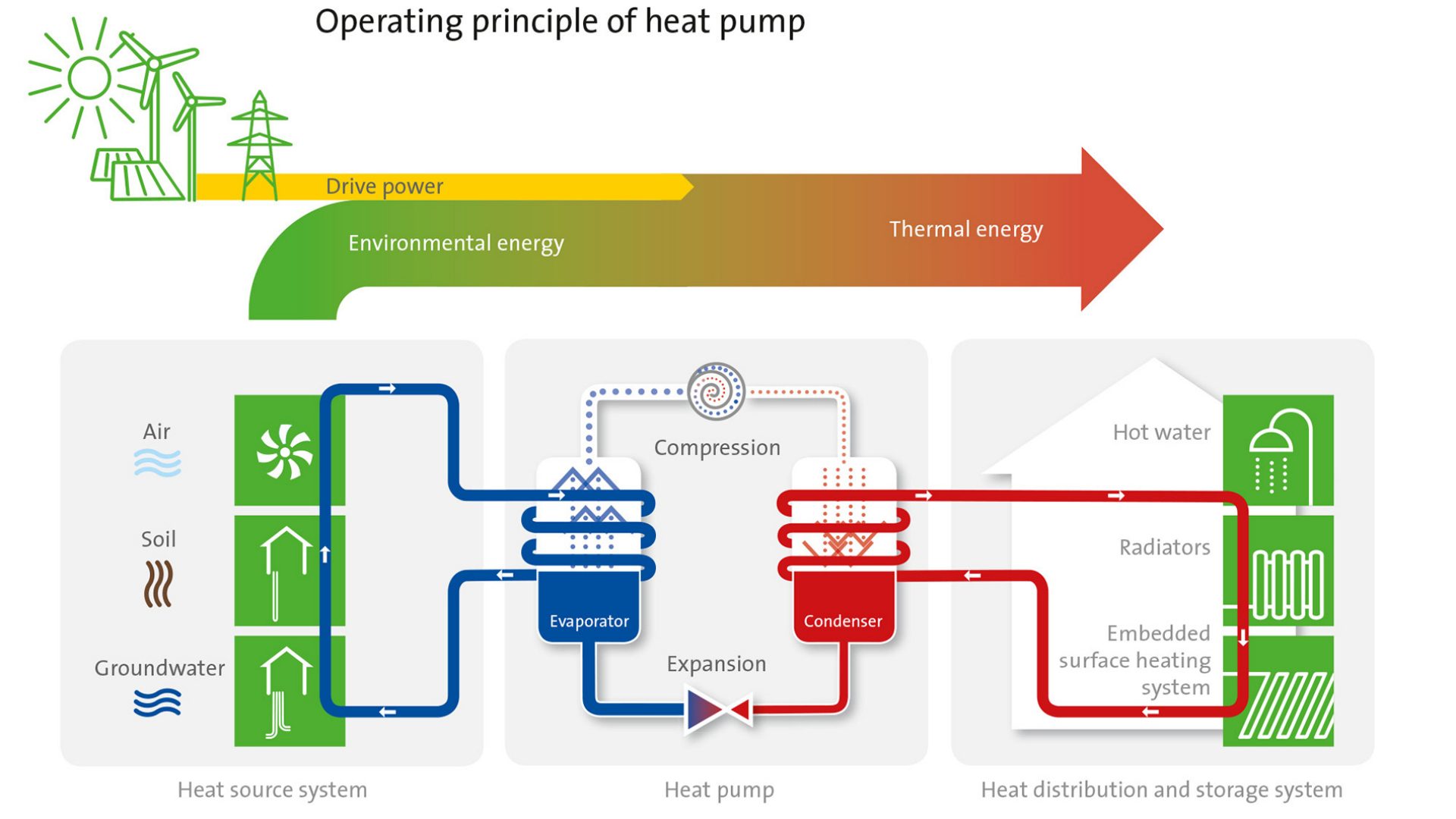At both the national level in the Climate Protection Plan 2050 of the Federal Government and at the international level on climate and resource protection, application of near-surface geothermal energy and environmental heat are given serious consideration and are the key to the heating revolution.
Utilisation generally takes place via brine-water, water-water or air-water heat pumps, which draw up to 80 % of the energy for heating and domestic hot water from the ground or the ambient atmosphere, and the remaining 20 % from electric drive energy. The "greener" the electricity becomes, the more environmentally friendly, i.e., more CO2 free the heat pump operation.
Using free environmental energy
The principle of operation of a heat pump is equivalent to that of a refrigerator. While a refrigerator extracts the heat and dissipates it outside, the heat pump uses the heat from each heat source and delivers it as heating energy to the building.
In the cooling circuit of the heat pump, while absorbing the heat from the environment, a refrigerant is evaporated and then the refrigerant vapour is compressed in a compressor. As a result of this, both the pressure in the cooling circuit and the temperature of the refrigerant rise. This heat is now released at a usable temperature level to the heating water. In the process, the refrigerant condenses and then expands in the expansion valve, and the cycle repeats itself.
Electric heat pumps use electricity as the drive energy and work very efficiently. Depending on the type of heat source, whether air, ground or water, one heat pump can generate between three and more than five kilowatt hours of heat from one kilowatt hour of drive electricity.
Heating, cooling and ventilation
The higher the temperature of the source, the more efficiently heat pumps work. Therefore, it is worthwhile to use a heat source at as high and as constant a temperature as possible. State-of-the-art heat pumps heat up domestic hot water as required, and can also be used to ventilate or cool a building.
The commercially available variants of heat pumps
Brine-water heat pumps: Heat from the ground can be harnessed as a heat source by using the brine-water heat pump. Geothermal probes are inserted into the ground through drilled holes of up to 200 meters (in most cases up to 100 m) and use the average ground temperature of about 10°C. If the plot of land is large enough or if drilling holes is not possible, the geothermal energy can also be tapped using a flat plate collector at a depth of 1.5 to 2 m or ground cages placed at a depth of about 1 to 4 m.
Water-water heat pumps: The water-water heat pump extracts the heat from the groundwater. A suction well conveys the water for heat recovery and the heat pump transfers the energy contained in the water to the heating system.
Air-water heat pumps: Air-water heat pumps extract heat from the ambient air. They are able to extract energy from the outdoor air even if its temperature has fallen to -20 °C or less. The investment costs of an air-water heat pump are lower because tapping the heat source is not required.
Schulung zum "Sachkundigen für Wärmepumpensysteme nach VDI 4645"
Fachbetrieb für Wärmepumpen finden
Modernisieren mit Wärmepumpe: Alles, was Sie wissen müssen
Kostenloses E-Learning/E-Teaching nicht nur für SHK-Azubis
Förderratgeber PDF-Datei, ca. 3 MB
Ratgeber Modernisieren mit Wärmepumpe PDF-Datei, ca. 9 MB
Logbuch Wärmepumpe PDF-Datei, ca. 1 MB


